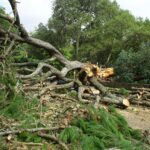At a glance:
- A formative pruning technique is used to guide the growth and development of young trees.
- It may seem simple at first glance, but formative pruning requires careful planning.
- Formative pruning increases sunlight and air circulation, promoting healthy growth and reducing the risk of disease.
Importance of tree growth and health
As a source of shade, clean air, and beauty, trees play an essential role in the environment. It is, however, essential to maintain the health and structure of these trees to ensure their longevity and vitality. As a result, the formative pruning of trees becomes necessary.
What is formative pruning?
A formative pruning technique is used to guide the growth and development of young trees. In this process, certain branches are selectively removed to improve the tree’s structural integrity and overall health. The benefit of this technique is that a well-structured tree will be more resistant to wind and snow and less likely to be damaged by them.
Maintaining tree health is also critical for its longevity. Having a healthy tree means reducing the chances of it contracting disease and pest infestations, both of which can be detrimental to its growth and survival. Well-pruned trees are also more likely to produce healthy foliage and fruit, making them an excellent investment for homeowners and orchard owners.
We will examine the many benefits of formative pruning in this article, including encouraging structural integrity, controlling tree size and shape, increasing sunlight and air circulation, reducing disease and pest infestation risk, and increasing fruit production. You may find this article useful whether you are a professional arborist or a homeowner who wants to maintain the health of their trees. Let’s begin!
How does Formative Pruning affect tree growth and health?
Removing Crossing or Rubbing Branches:
The purpose of formative pruning is to remove branches that cross each other or rub against one another so that the tree will not suffer further damage. As a result, the canopy becomes more open, providing better access to light and air. By improving light penetration, all parts of the tree receive adequate light, which is critical for photosynthesis, and air circulation is improved, which reduces the likelihood of fungus and bacteria growth.
Selecting a Central Leader or Dominant Branch:
The selection of a central leader or dominant branch is another benefit of formative pruning. By doing so, the tree is built with a strong and balanced structure that can withstand high winds or heavy snow without splitting or breaking. In order for the tree to withstand harsh weather conditions, it needs to have a strong and stable central leader or dominant branch.
Removing Co-Dominant Leaders or Weak Branches:
It is also a good idea to remove weak or co-dominant branches during formative pruning. In this way, structural defects can be prevented in the future, and branch failures can be reduced. As a result of competition for dominance among co-dominant leaders, weak attachments to the trunk may occur. Formative pruning promotes a strong, stable tree structure and a single dominant leader by removing these weak branches early on.
What are the different techniques of Formative Pruning?
It may seem simple at first glance, but formative pruning requires careful planning and execution to ensure the best results. The following are some techniques for formative pruning:
Choosing and removing the right branches:
When performing formative pruning, it is critical to remove only the right branches. Branches that cross, rub, or are weak should be removed to avoid structural and disease issues. The tree should also have enough foliage to encourage healthy growth.
When to prune:
Timing is crucial for formative pruning. To avoid stressing the tree and to allow it to heal properly, it should be done during the dormant season. Generally, this involves pruning during the winter months at a time when the tree is not actively growing.
Using the correct equipment and techniques:
To ensure the success of formative pruning, it is imperative to use the right equipment. To promote healing, you should use sharp, clean pruning tools to prevent damage to the tree. Making clean, angled cuts are also crucial to minimising tree damage when pruning trees.
Some of the essential gears are:
- Pruning shears or a pruning saw with sharp blades
- For trees that are too tall to reach from the ground, you may need a ladder.
- Gear that protects the eyes and hands, such as gloves and goggles.
In order to begin the process of formative pruning, it is important to have the right knowledge and tools. The best option is to invest in affordable tree pruning services in Melbourne.
What is the best time for formative pruning?
According to the type of tree being pruned, the best time for formative pruning will vary. Before new growth starts, formative pruning should be performed in late fall, winter, or early spring, when the trees are dormant. When trees’ growth has slowed down during the dormant season, they are less susceptible to damage or stress.
This rule, however, has some exceptions. Birch and maple trees, for example, are prone to bleeding sap if pruned in late winter or early spring. For this reason, it’s best to wait until mid-summer to prune these trees.
Pruning should also be avoided during periods of extreme weather conditions, such as during a heat wave or a frosty period. As a result, the tree may become stressed and more vulnerable to disease and pest infestations.
Considerations for pruning in different seasons
A plant’s growth habits, the purpose of pruning, and the season all play a role in the timing of pruning. Depending on the season, you should take the following into consideration:
Winter pruning:
As deciduous trees, shrubs, and vines are dormant during the winter, it is an excellent time to prune them as their structure is visible. By pruning during the winter, plants grow stronger in the spring and diseases are prevented from spreading. Plants that are frozen or exposed to extreme cold temperatures should not be pruned.
Spring pruning:
For roses, butterfly bushes, and crepe myrtles that bloom on new growth, spring pruning is best. Spring pruning promotes healthy new growth and enhances the plant’s appearance. The plant may, however, produce fewer flowers if pruned late in the spring when buds are developing.
Summer pruning:
For hedges, fruit trees, and evergreens, summer pruning is the most suitable time. In the summer, pruning works to control the size and shape of the plant. The plant should never be pruned during hot and dry weather or when it is stressed, as it may be damaged.
Fall pruning:
Getting rid of dead or diseased branches in the fall is the best way to prevent the disease from spreading to healthy plants. In addition to helping the plant prepare for winter dormancy, fall pruning encourages healthy spring growth. It’s best to avoid pruning in late fall when the plant is preparing for dormancy, as it stimulates new growth that is susceptible to winter damage.
What are the advantages of Formative Pruning?
Here, we will discuss formative pruning and its benefits for tree growth and health.
Maintain structural integrity:
The goal of formative pruning is to guide the tree’s growth by removing weak, competing, and crossing branches to prevent structural problems later on. The tree can withstand harsh weather conditions by developing a stronger and more resilient structure by removing these branches early on.
Controls tree size and shape:
It is especially important for trees in small spaces to perform formative pruning in order to control the size and shape of the trees. With selective branch removal, the tree can be trained to grow in a particular direction, resulting in a more appealing appearance.
Circulates more sunlight and air:
When trees are pruned formatively, more sunlight and air circulation reach the interior, which promotes healthy growth and reduces the risk of disease. By increasing airflow, trees growing in damp and dark environments are less likely to suffer from fungal growth.
Prevents disease and pest infestations:
It is important to remove dead, diseased, or damaged branches during formative pruning to reduce disease and pest infestation risks. Leaving these branches untreated can spread insects and fungi to healthy parts of the tree.
Boosts fruit production:
It is particularly important for fruit trees to prune formatively because it can increase fruit production. Trees produce larger and more abundant fruit when excess branches are removed, and their energy is focused on fruit-bearing branches.
Factors to consider when pruning mature trees.
It is challenging and potentially dangerous to prune mature trees. In order to do this, it is necessary to understand the tree’s growth habits, structure, and health. The following factors should be considered when pruning mature trees:
Objectives of pruning:
An important step in pruning a mature tree is to determine its objectives. It is common for mature trees to be pruned in order to remove dead or diseased branches, improve their structure and appearance, reduce the risk of property damage or personal injury, and promote new growth.
Tree species and growth habits:
A tree’s crown shape, branch angles, and growth rate can differ depending on its species. To ensure pruning techniques are appropriate for the tree’s species, it is important to understand the tree’s growth habits before pruning.
Tree size and location:
Equipment and pruning techniques will depend on the size and location of the tree. It may be necessary to use specialised equipment, such as a crane or bucket truck, if the tree is located near a building or power lines.
Health and condition of the tree:
Before pruning a mature tree, consider its health and condition to ensure it is able to handle the pruning. Pruning may not be a good option for a stressed, diseased, or damaged tree.
Timing of pruning:
It is crucial to prune the tree at the right time for it to remain healthy. It is possible for a tree to become infected with disease or pests if it is pruned at the wrong time of year. Generally, mature trees should be pruned during the dormant season or in late spring after they have grown seasonally.
Pruning techniques:
Trees that are mature can be pruned with several pruning techniques, such as crown thinning, crown raising, and crown reduction. Depending on the tree’s growth habits, size, and pruning objectives, it’s important to use the appropriate pruning technique.
Conclusion
In summary, formative pruning refers to the process of removing select plant parts to shape and maintain the health of a tree. In addition to promoting optimal growth, it enhances the appearance of the plant, as well as reducing disease and pest risks. Keeping trees healthy and long-lived requires professional pruning. When choosing the timing and techniques for pruning, it’s important to consider the tree’s species, growth habits, size, location, health, and objectives.
A professional arborist, such as Same Day Tree Works, is the best choice when it comes to formative pruning. Arborists with extensive experience can advise you on the best pruning practices for your trees to achieve optimal growth and health. Call the affordable tree service provider in Melbourne today for all your tree pruning needs before it’s too late.





